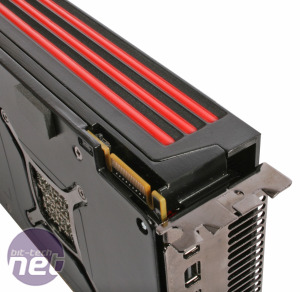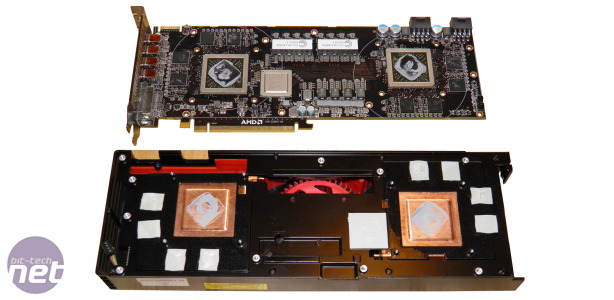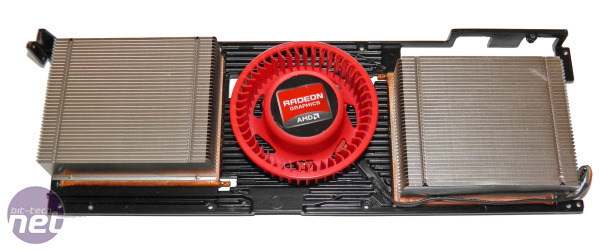Antilles Unlocking Switch
Much has been made of the dual BIOS feature of the HD 6900 cards, particularly the ability to convert a Radeon HD 6950 2GB into a Radeon HD 6970 2GB, and this feature remains with the HD 6990 4GB. With the dual-GPU card, AMD has performed the BIOS hacking for us, giving you a read-only BIOS primary BIOS, while the secondary BIOS clocks up the GPUs to 880MHz to match the clock speed of the HD 6970 2GB, as well as upping the vcore of each GPU by 0.055V.To reflect this, the switch on top of the card has been renamed as the Antilles Unlocking Switch. As a consequence of the increased frequency and voltage, the card’s already monstrous power consumption shoots up from 375W to 450W. This means that it requires 187.5W from each of the two 8-pin PCI-E power connectors (with up to 75W coming from the motherboard slot). If your PSU has a single 12V rail, it will need to deliver more than 31A just to power the card, let alone the rest of your PC. If your PSU uses two or more rails, you’ll probably need to ensure that the PCI-E connectors come from different rails.


The Dual BIOS switch (just behind the CrossFire connector) switches the card from its standard clock speeds to an overclocked mode
AMD’s explanation of this choice of modes is that cheap PSUs will struggle to deliver enough power via the 12V rail to stably run the card in its overclocked mode. However, high-wattage enthusiast PSUs will have no trouble. We’re suspicious that AMD is trying to have its cake and eat it too.
During our briefing with AMD, we were constantly told of its efforts to make the HD 6990 4GB cool and quiet, and yet the vast majority of the comparative performance data was based on the much hotter and louder overclocked mode. Most concerning is that AMD says that you void your warranty by using the Antilles Unlocking Switch – this is a ridiculous decision considering that the switch is a standard feature of all cards.
The two GPUs are arranged in a symmetrical design
By chomping its way through so much power, especially in its overclocked mode, the HD 6990 4GB also presents a thermal problem – just how do you disperse so much heat from a dual-slot expansion card? AMD’s solution is to use a high-capacity vapour chamber for each GPU to efficiently pull the heat from the GPUs into the attendant heatsinks. Airflow is provided from a centrally mounted radial fan that blows air over both heatsinks, exhausting hot air out of the card’s rear and into the case.
By using what it calls phase-change TIM (TIM that cures and hardens), AMD claims it has improved thermal performance by 8 per cent in comparison to its past TIM. However, we were advised that disassembling the card breaks this cured TIM, which cannot be reset, so we performed all our tests before disassembling the card.
Dual vapour chambers handle the cooling.
Cooling the card’s memory is also more complex than usual. AMD has had to mount half of the memory for each GPU on the back of the card, and each GPU is serviced by eight 256MB modules. As such, a backplate has been used to passively cool the memory fitted on the back of the card, and this is probably the reason why the HD 6990 4GB ships with a comparatively conservative memory speed of 5GHz (effective).

MSI MPG Velox 100R Chassis Review
October 14 2021 | 15:04











Want to comment? Please log in.